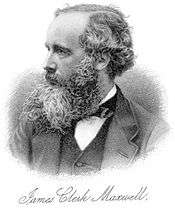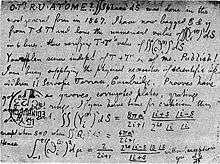A Dynamical Theory of the Electromagnetic Field
| Author | James Clerk Maxwell |
|---|---|
| Language | English |
| Subject | Classical electromagnetism |
| Genre | Scientific paper |
| Publisher | Philosophical Transactions of the Royal Society |
Publication date | 1865 |
A Dynamical Theory of the Electromagnetic Field is the third of James Clerk Maxwell's papers regarding electromagnetism, published in 1865.[1] In the paper, Maxwell derives an electromagnetic wave equation with a velocity for light in close agreement with measurements made by experiment, and deduces that light is an electromagnetic wave.
Publication
Following standard procedure for the time, the paper was first read to the Royal Society on 8 December 1864, having been sent by Maxwell to the Society on 27 October. It then underwent peer review, being sent to William Thompson (later Lord Kelvin) on 24 December 1864.[2] It was then sent to George Gabriel Stokes, the Society's Physical Sciences Secretary, on 23 March 1865. It was approved for publication in the Philosophical Transactions of the Royal Society on 15 June 1865, by the Committee of Papers (essentially the Society's governing Council) and sent to the printer the following day (16 June). During this period, Philosophical Transactions was only published as a bound volume once a year,[3] and would have been prepared for the Society's Anniversary day on 30 November (the exact date is not recorded). However, the printer would have prepared and delivered to Maxwell offprints, for the author to distribute as he wished, soon after 16 June.
Maxwell's original equations
In part III of the paper, which is entitled "General Equations of the Electromagnetic Field", Maxwell formulated twenty equations[1] which were to become known as Maxwell's equations, until this term became applied instead to a vectorized set of four equations selected in 1884, which had all appeared in "On physical lines of force".[4]
Heaviside's versions of Maxwell's equations are distinct by virtue of the fact that they are written in modern vector notation. They actually only contain one of the original eight—equation "G" (Gauss's Law). Another of Heaviside's four equations is an amalgamation of Maxwell's law of total currents (equation "A") with Ampère's circuital law (equation "C"). This amalgamation, which Maxwell himself had actually originally made at equation (112) in "On Physical Lines of Force", is the one that modifies Ampère's Circuital Law to include Maxwell's displacement current.[4]
- For his original text on force, see:
 On Physical Lines of Force. Wikisource.
On Physical Lines of Force. Wikisource. - For his original text on dynamics, see:
 A Dynamical Theory of the Electromagnetic Field. Wikisource.
A Dynamical Theory of the Electromagnetic Field. Wikisource.
Heaviside's equations
Eighteen of the twenty original Maxwell's equations can be vectorized into 6 equations. Each vectorized equation represents 3 original equations in component form. Including the other two equations, in modern vector notation, they can form a set of eight equations. They are listed below:
- (A) The law of total currents
- (B) Definition of the magnetic potential
- (D) The Lorentz force
This Maxwellian electromotive force represents the effect of electric fields created by convection, induction,[5] and by electric charges.
- (E) The electric elasticity equation
- (F) Ohm's law
- (G) Gauss's law
- (H) Equation of continuity of charge
- Notation
- is the magnetic field, which Maxwell called the "magnetic intensity".
- is the electric current density (with being the total current including displacement current).
- is the displacement field (called the "electric displacement" by Maxwell).
- is the free charge density (called the "quantity of free electricity" by Maxwell).
- is the magnetic potential (called the "angular impulse" by Maxwell).
- is the force per unit charge (called the "electromotive force" by Maxwell, not to be confused with the scalar quantity that is now called electromotive force; see below).
- is the electric potential (which Maxwell also called "electric potential").
- is the electrical conductivity (Maxwell called the inverse of conductivity the "specific resistance", what is now called the resistivity).
- ∇ is the vector operator del.
Maxwell did not consider completely general materials; his initial formulation used linear, isotropic, nondispersive permittivity ε and permeability μ, although he also discussed the possibility of anisotropic materials.
It is of particular interest to note that Maxwell includes a term in his expression for the "electromotive force" at equation "D", which mathematically corresponds to the magnetic force per unit charge on a moving conductor with velocity . This means that equation "D" is effectively the Lorentz force. This equation first appeared at equation (77) in "On Physical Lines of Force" quite some time before Lorentz thought of it.[4] In the modern age, the force equations described by Hendrik Lorentz are placed alongside Maxwell's equations as an additional electromagnetic equation that is not included as part of the set.
When Maxwell derives the electromagnetic wave equation, he uses equation "D" as opposed to using Faraday's law of electromagnetic induction as in modern textbooks. Maxwell however drops the term from equation "D" when he is deriving the electromagnetic wave equation, and he considers the situation only from the rest frame.
Maxwell – electromagnetic light wave


In part VI of "A Dynamical Theory of the Electromagnetic Field",[1] subtitled "Electromagnetic theory of light",[6] Maxwell uses the correction to Ampère's Circuital Law made in part III of his 1862 paper, "On Physical Lines of Force",[4] which is defined as displacement current, to derive the electromagnetic wave equation.
He obtained a wave equation with a speed in close agreement to experimental determinations of the speed of light. He commented,
The agreement of the results seems to show that light and magnetism are affections of the same substance, and that light is an electromagnetic disturbance propagated through the field according to electromagnetic laws.
Maxwell's derivation of the electromagnetic wave equation has been replaced in modern physics by a much less cumbersome method which combines the corrected version of Ampère's Circuital Law with Faraday's law of electromagnetic induction.
Modern equation methods
To obtain the electromagnetic wave equation in a vacuum using the modern method, we begin with the modern 'Heaviside' form of Maxwell's equations. Using (SI units) in a vacuum, these equations are
If we take the curl of the curl equations we obtain
If we note the vector identity
where is any vector function of space, we recover the wave equations
where
meters per second
is the speed of light in free space.
Legacy and impact
Of this paper and Maxwell's related works, fellow physicist Richard Feynman said: "From the long view of this history of mankind - seen from, say, 10,000 years from now - there can be little doubt that the most significant event of the 19th century will be judged as Maxwell's discovery of the laws of electromagnetism."
Albert Einstein used Maxwell's equations as the starting point for his Special Theory of Relativity, presented in The Electrodynamics of Moving Bodies, a paper produced during his 1905 Annus Mirabilis. In it is stated:
- "the same laws of electrodynamics and optics will be valid for all frames of reference for which the equations of mechanics hold good"
and
- "Any ray of light moves in the "stationary" system of co-ordinates with the determined velocity c, whether the ray be emitted by a stationary or by a moving body."
Maxwell's equations can also be derived by extending General Relativity into five physical dimensions.
See also
References and notes
- General
| Wikisource has original text related to this article: |
- Citations
- 1 2 3 Maxwell, James Clerk (1865). "A dynamical theory of the electromagnetic field" (PDF). Philosophical Transactions of the Royal Society of London. 155: 459–512. doi:10.1098/rstl.1865.0008. (This article followed a December 8, 1864 presentation by Maxwell to the Royal Society.)
- ↑ Royal Society archives; register of papers
- ↑ https://royalsociety.org/~/media/library/The%20library%20and%20archives%20of%20the%20royal%20society%201660-1990%20Marie%20Boas%20Hall.pdf
- 1 2 3 4 Maxwell, James Clerk (1861). "On physical lines of force" (PDF). Philosophical Magazine.
- ↑ See: Electromagnetic induction and Electrostatic induction
- ↑ A Dynamical Theory of the Electromagnetic Field/Part VI
Further reading
- Maxwell, James C.; Torrance, Thomas F. (March 1996). A Dynamical Theory of the Electromagnetic Field. Eugene, OR: Wipf and Stock. ISBN 1-57910-015-5.
- Niven, W. D. (1952). The Scientific Papers of James Clerk Maxwell. Vol. 1. New York: Dover.
- Johnson, Kevin (May 2002). "The electromagnetic field". James Clerk Maxwell – The Great Unknown. Retrieved Sep 7, 2009.
- Tokunaga, Kiyohisa (2002). "Part 2, Chapter V – Maxwell's Equations". Total Integral for Electromagnetic Canonical Action. Retrieved Sep 7, 2009.
- Katz, Randy H. (February 22, 1997). "'Look Ma, No Wires': Marconi and the Invention of Radio". History of Communications Infrastructures. Retrieved Sep 7, 2009.